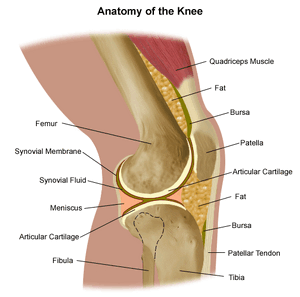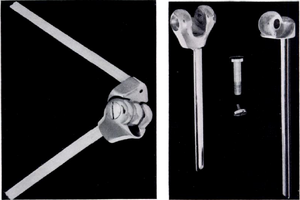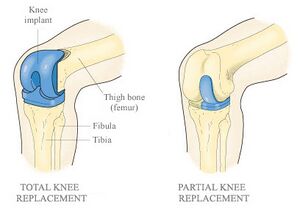Knee Replacements, by David Ferreira

Background
Knee replacement, also known as knee arthroplasty ("surgical repair of joint") is a procedure that consists of removing damaged cartilage and replacing damaged weight-bearing surfaces within the knee joint. Generally, the replacement joint consists of a combination of metal and plastic components. This combination of materials optimizes the strength of the joint while also cushioning the components from damage due to shock and friction.
Osteoarthritis is a condition characterized by the degradation of the layers articular cartilage and the underlying bone, which can lead to intense pain and loss of joint functionality. Osteoarthritis is the most common motivation for performing knee arthroplasty. Inflammatory forms of arthritis, such as rheumatoid arthritis and psoriatic arthritis, can occur either independently, or as secondary complications of osteoarthritis, and can also make knee replacement necessary.
History

- 1954 First publication on the subject of artificial knee joints, by Leslie G. P. Shiers. The joints described in this publication had movement in only one plane of motion.[2]
- 1971 Frank H. Gunston pioneers knee replacement procedures in North America with the development of the polycentric knee joint, which had smoother rotation than Shiers' model, as well as offering additional planes of motion for the knee (more closely approximating a normal knee joint).[3]
Pre-operation
Prior to surgery, a number of preparative measures should be taken. These include exercises to strengthen the ankle, knee, and hip joints in the month leading up to surgery, as well as standard pre-operational blood and general health tests.[4]
Procedures
Initially, an incision is made down the front of the knee. A cut is made in the quadriceps muscle in order to allow the patella to be moved to one side of the knee joint. Damaged cartilage and bone is trimmed away, and the ends of the femur and tibia are carefully shaped to match the corresponding surfaces of the artificial joint inserts. The metal components are then attached to the resurfaced ends of the tibia and femur. A plastic spacer, most commonly made of polyethylene, is placed on top of the tibial component of the joint. This spacer adds cushioning to the joint and provides a smooth surface for the upper section of the joint to glide along, reducing metal-on-metal wear. The surgeon then takes the knee through a series of range-of-motion tests to ensure that the new joint will not be restricted in movement. After this, any incisions made during the surgery are repaired, and the knee is sewn or stapled shut.[1]
During the procedure, the surface of the patella may also be reshaped, with an additional plastic insert added to the new surface. There is little evidence that patellar resurfacing results in significant improvements in joint function or recovery time, and some studies have found that the procedure leads to a migher likelihood of joint pain and complications.[5] For this reason, this procedure is not universally practiced, varying between surgeons based on personal preference.
An animated video of the general procedure can be found here.
Partial Knee Replacement

Some cases of knee damage are localized to a small area of the knee, indicating that not all surfaces of the knee joint require replacement. In these situations, partial knee arthroplasty can be performed, effectively replacing only those areas of the joint that are damaged. Partial knee replacements are much less invasive than total knee replacements, as the initial incision can be much smaller due to the reduced size of the components to be inserted. However, partial knee arthroplasties are much less common than total knee replacements, due to the specific conditions that need to be met in order for a partial replacement to be the appropriate solution.[7]
Recovery
The average timeline of the recovery process following a total knee replacement procedure is shown below (the listed times are approximately halved in the case of a partial knee replacement)
- Hospital discharge after 4-6 days
- 3-6 weeks of regular physical therapy. After 6 weeks, most patients are able to walk with support from a cane.
- After 3 months, most patients are able to walk unaided, and participate in low-impact activities such as swimming, golfing, and bicycling. However, in many cases, support may be necessary for as long as 6 months following surgery.[8]
Minimally-Invasive Surgery
Knee arthroplasty is physically possible with much smaller incisions, resulting in reduced recovery time and decreased likelihood of post-surgical infection. However, the reduction in cut size leads to a lessened ability for the surgeon to see inside the joint, leading to poorer placement of the artificial joint. Work is being done to develop computer-aided surgical procedures in order to improve the accuracy of joint placement. Additional studies are exploring other ways to displace the patella during surgery without severing the quadriceps tendon. The goal is to reduce recovery time by minimizing the number of incisions that must heal.
References
-
"Knee Replacement Surgery Procedure." Johns Hopkins Medicine. Johns Hopkins Medicine, n.d. Web. 11 Feb. 2014.
-
Shiers, L. G. P. "Arthroplasty of the Knee: Preliminary Report of a New Method." The Journal of Bone and Joint Surgery 36 B.4 (1954): 553-60. The Bone & Joint Journal. Web. 11 Feb. 2014.
-
Gunston, Frank H. "Polycentric Knee Arthroplasty." Journal of Bone and Joint Surgery 53 B.2 (1971): 272-77. The Bone & Joint Journal. Web. 11 Feb. 2014.
-
"Knee Replacement Surgery." DePuy.com. N.p., n.d. Web. 12 Feb. 2014. <http://www.depuy.com/patients-and-caregivers/knee/knee-replacement?t=preparing+for+surgery>.
-
Khan A, Pradhan N. Results of total knee replacement with/without resurfacing of the patella. Acta Ortop Bras. [online]. 2012;20(5): 300-2.
-
"Partial Vs. Total Knee Replacement." Knee Replacement Costs. N.p., n.d. Web. 12 Feb. 2014. <http://www.kneereplacementcosts.com/partial-vs-total.html>.
-
"Unicompartmental Knee Replacement." Unicompartmental Knee Replacement-OrthoInfo - AAOS. American Academy of Orthopaedic Surgeons, n.d. Web. 11 Feb. 2014.
-
"Rehabilitation Timeline." KneeReplacement.com. N.p., n.d. Web. 11 Feb. 2014. <https://www.kneereplacement.com/About/rec_rehab/rehab_timeline>.
